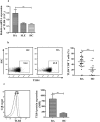Direct recognition of LPS drive TLR4 expressing CD8+ T cell activation in patients with rheumatoid arthritis
- PMID: 28424490
- PMCID: PMC5430440
- DOI: 10.1038/s41598-017-01033-7
Direct recognition of LPS drive TLR4 expressing CD8+ T cell activation in patients with rheumatoid arthritis
Abstract
Aberrant immune responses characterize autoimmune disorders like Rheumatoid Arthritis (RA) wherein lymphocytes are recognized as key players. Role of CD8+ T cells in RA has been less defined however we found that these cells are activated in RA patients with increased expression of cytolytic granules and inflammatory mediators thereby modulating immune responses contributing to disease severity. Though unconventional expression of different Toll Like Receptors (TLRs) on CD8+ T cells has been proposed but their expression and role in T cell activation and differentiation in RA still remains obscure. Herein we report, for the first time, an increased expression of TLR4 on peripheral CD8+ T cells of RA patients and its role in skewing CD8+ T cells towards activated and inflammatory phenotype thereby playing a significant role in pathogenesis and progression of RA. We found that the surface expression of TLR4 on CD8+ T cells directly correlates with disease severity. Moreover, these CD8+ T cells respond to the TLR4 ligand LPS and express robust amounts of cytotolytic and inflammatory molecules including TNFα and IFNγ. Our study hence identifies an important role for CD8+ T cells in orchestrating RA through TLR4 mediated activation and differentiation.
Conflict of interest statement
The authors declare that they have no competing interests.
Figures




References
MeSH terms
Substances
LinkOut - more resources
Full Text Sources
Other Literature Sources
Medical
Research Materials

